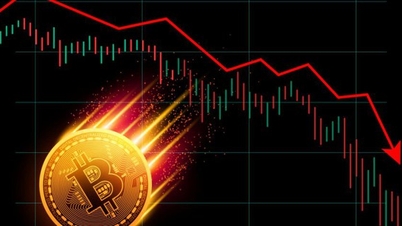 |
| Germany's public debt has been rising since 1950 and by the third quarter of 2023, it will stand at 2.5 trillion euros, or about $2.68 trillion. (Source: DPA) |
Fears about consumer debt are of considerable concern in Germany, with local media recently reporting on the country's public debt.
Germany's public debt continued to rise in the first quarter of 2023, reaching a record €2,406.6 billion ($2,628.4 billion), according to the Federal Statistics Office (Destatis). Compared to the end of 2022, this figure increased by €38.8 billion in the first quarter of 2023, mainly due to the increased financial needs of the federal government to cope with the energy crisis.
However, the British magazine The Economist commented that while Germany today faces many problems, debt is not among them.
The discussions over Germany's debt levels come after the Federal Constitutional Court ruled that the government's plan to repurpose 60 billion euros (65 billion USE) of Covid-19 relief was unconstitutional.
German Finance Minister Christian Lindner said Berlin faces a 17 billion euro ($18.66 billion) shortfall in next year's budget following the ruling. Without the cash needed to make major investments, the government must now make drastic adjustments to its 2024 budget.
The question is, is the German government likely to collapse? Should the country continue borrowing and ignore the constitutional debt brake or rein in state spending?
When does debt become dangerous?
The basic fear is that Germany's national debt could become a problem. But when will that happen? The simple answer is whenever it becomes expensive for countries to borrow.
Sovereign debt could become particularly costly if figures like Christian Esters, head of ratings at US ratings agency S&P, downgrade Germany. S&P is considered the world's largest and most influential rating agency - ahead of Moody's and Fitch, two other US firms.
The credit ratings from Esters and his team can have far-reaching implications. Their assessments determine whether countries are considered bankrupt and how much they will have to pay for new loans. The lower their credit rating, the higher the cost of new loans.
Discussions often focus on total public debt. In Germany, many people are familiar with the Schuldenuhr, or debt clock, which shows the country's public debt to the public.
The debt of Europe's top economy has been rising since 1950 and stood at 2.5 trillion euros ($2.68 trillion) in the third quarter of 2023. This puts Germany in third place among countries with the highest public debt in the eurozone, after France and Italy.
However, Mr. Esters believes that total public debt is not an important measure. He told DW : "Government debt should absolutely not be placed in correlation with the size of a country's economy."
Sometimes national debt per capita is discussed instead. In Germany, national debt per capita is currently 31,000 euros ($33,320).
However, this metric does not help assess a country’s overall creditworthiness. By this measure, countries in the global north often appear significantly more indebted than populous countries in the global south. But comparing rich and poor countries is also misleading, Esters says.
He said that public debt is only one factor considered when conducting credit ratings, "in addition, there are a number of other factors, such as how much the state budget spends on interest payments."
The higher the interest rate, the more debt there is. However, interest rates also depend on the rate of inflation in the sense that central banks try to fight inflation by raising interest rates.
“Inflation is one of the factors that determine the effectiveness and reliability of monetary policy,” the expert said.
In terms of inflation, Germany ranks in the middle of the pack compared to other countries around the world. Although global inflation has picked up slightly in recent years, it remains moderate compared to the 1980s and 1990s, suggesting that inflation needs to be taken seriously.
“High inflation can lead to a reduction in purchasing power and a reduction in a country’s international competitiveness,” said a US credit rating expert. Thus, inflation is the “key” to determining a country’s creditworthiness.
Political factors also influence how much states pay for new loans, Esters said. “It’s important to emphasize that we’re not just looking at financial factors,” he said.
The deciding factor is political risk.
In particular, recent years have shown that institutional predictability and stability play an important role. Countries can fall into debt crises when their political institutions are weak.”
This could create a vicious cycle. After all, debt can play a significant role in weakening political institutions. According to S&P, global government debt has increased by an average of 8% of GDP since the Covid-19 pandemic (early 2020), which has increased pressure on national budgets, especially when interest rates are high.
“A larger proportion of government revenue has to be spent on interest and this reduces fiscal flexibility, for example to respond to future shocks or crises,” the expert said.
Government debt should be matched by household savings. In Germany, for example, many people still save a lot.
S&P has flagged an improvement in Germany’s credit rating for 2023, despite the huge debt it has incurred in recent years for Covid-19 bailouts, economic restructuring and support for Ukraine in its conflict with Russia. However, looking ahead to the coming years, things are not looking so promising.
“We expect more negative than positive changes in credit ratings over the next one to two years,” Mr. Esters said, adding that the deciding factor is political risk, not debt.
The world's leading credit rating expert is also optimistic about Germany's future despite the possibility of new debts. He said that even in 2010, when the Western European country's public debt was at 80% of GDP, there was no doubt about the country's creditworthiness and Germany's rating remained at the highest level - AAA.
Source




![[Photo] Prime Minister Pham Minh Chinh receives President of Cuba's Latin American News Agency](/_next/image?url=https%3A%2F%2Fvphoto.vietnam.vn%2Fthumb%2F1200x675%2Fvietnam%2Fresource%2FIMAGE%2F2025%2F12%2F01%2F1764569497815_dsc-2890-jpg.webp&w=3840&q=75)








































































































Comment (0)